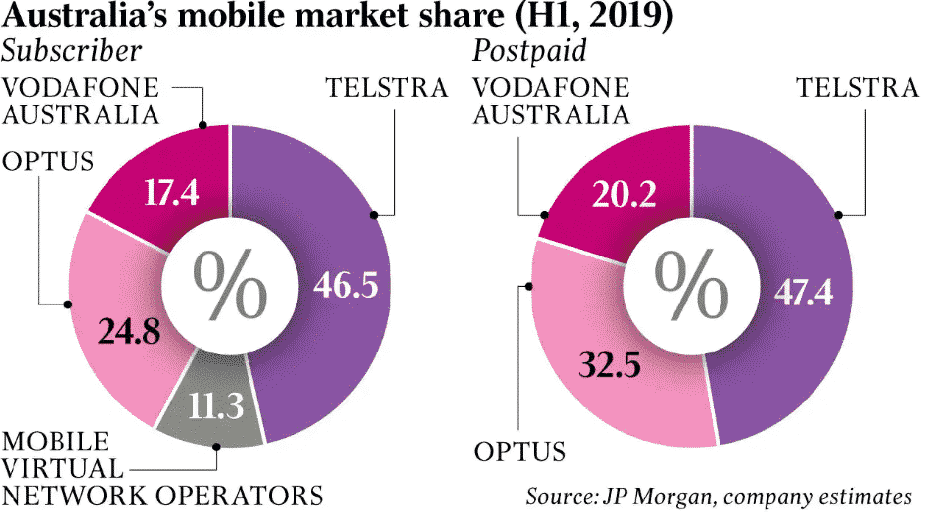NU Mobile’s strategy places it in competition with both MVNOs and MNOs
NU Mobile rebrands an already tested strategy — used phone offers to customers. The difference this time, though, is that the used phones will come attached to NU Mobile plans — not SIM-only as previous MVNOs did — which make use of the Telstra network.
NU Mobile is a new MVNO (Mobile Virtual Network Operator) making use of the Telstra network. This places it in direct competition with a number of other MVNOs, of which Amaysim is the market leader.
These MVNOs have been a hit with consumers, as they’ve been able to offer some very competitive pricing schemes to custumers in the SIM-only arena. In fact, despite their small market share in the telco industry as a whole, MVNOs are a growing threat to the major telcos, even though they latch on to their networks.
But the fact that NU Mobile’s strategy is to offer these used phones with contract plans on Telstra’s network also puts it in direct competition with the major telcos — or MNOs (Mobile Network Providers) — as opposed to the SIM-only dominant MVNO market, and these major telcos are as dominant as they com
MNOs in general, especially Telstra, dominate both the prepaid (SIM-only) and postpaid (contract) market by far, dwarfing the efforts of MVNOs, even though MVNOs are gaining momentum. Source.
This already seems like a complicated position to be in, and the position was already complicated given the fact that the idea of used phones has been tried and abandoned on several occasions by other companies.
The NU Mobile story
NU Mobile is a product of Macquarie, the financial services giant. The company was involved in the business of leasing mobile phones to mobile retailers, who in turn lease them to customers. At the end of the contractual lease, the customers return those phones to the mobile retailer, and it ends up back in Macquarie’s hands.
This means Macquarie is sitting on a pile of second-hand phones — over a million, apparently — hence the NU Mobile offer.
This all sounds good from a distance, especially when you factor in the fact that customers are beginning to hold on to their mobile phones a lot longer, rather than spending a ton on the latest upgrades that seem to get pricier by the year. This may imply that consumers may not mind second hand mobile phones, especially where those second hand phones are quite cheap compared to the exorbitantly priced latest models.
But is this really the case? After all, this strategy has been tried a couple of times before — at least in part — by other companies, and they all bailed before we knew it.
Previous attempts at the second-hand market
The idea of selling devices, in general, hasn’t been a good one for MVNOs. A number of them have tried this, but it simply hasn’t worked, and they eventually ended up pulling out of the market.
One of the MVNO market leaders, Amaysim, did just that when it launched its device store in October 2017 to offer aggressively-priced phones to costumers, from major brands like Samsung and Apple. There was also the goal of offering financing for those phones in the future, without any lock-in contract.
Despite how good it all sounded, Amaysim announced its intention to pull out of the market in the first half of this year, 2019 — less than two years later. Although the company’s revenue grew significantly in less than a year, its profits dropped 76 percent — an even more significant figure.
Moose Mobile, another MVNO, also explored the device business by offering customers refurbished iPhones. However, the company abandoned the strategy in no time.
Whatever the reasons given for the get-in-and-get-out summaries of these MVNO’s device selling explorations, the fact remains that the get-out part of it all has been quite consistent. The concept just doesn’t seem to work, and for good reason.
Too many questions surround the device selling concept for MVNOs
NU Mobile is entering different market sectors at the same time, which in turn invites competition from more than one sector — both major telcos that offer contract plans and phone financing, and MVNOs.
Telstra, the network which NU Mobile will couch on, currently owns almost 50 percent of the postpaid contract market and 42 percent of the handset market.
In addition, assuming NU Mobile was to only finance its second-hand phones and offer SIM-only plans (which would be a complicated concept) alongside them, the MVNO market comes with enough competition in the pre-paid realm as it is.
The Australian prepaid market has seen a 29.4 percent share go to MVNOs, of which ALDImobile and Amaysim are the leaders, with a slew of other companies slugging it out for the $794 million MVNO market — a paltry market when compared to the $24 billion mobile phone market, and considering the fact that, of that $794 million MVNO market revenue, there’s only $84 million in profit to go around.
MVNO’s market share in the Australian prepaid market continue to increase, while the major telcos share in the same market declines. However, major telcos are beginning to offer some very competitive pricing on their pre-paid offers, which may change the trend in coming years. Also, despite the increase in market share, MVNOs only see a tiny return in profit. Source.
The competition is simply too much in the MVNO sector alone, and NU Mobile chooses to also battle with the majors in the contract market. This doesn’t seem to be a feasible strategy.
Yes, Macquarie is sitting on a pile of second-hand phones that it probably doesn’t want to throw away, and so it might as well make more money from them through a scheme like this. But the company is likely to lose money in this endeavor, just like Amayasim’s 76 percent profit loss.
Yes, Australians aren’t big on the latest devices anymore, and this might mean they are open to the idea of second-hand phones, but this isn’t the likely option for Aussies to choose. Yes, the concept of cheap, second-hand phones offered on financed, contract plans is a new one, but it likely will be shelved like previous MVNO attempts at device sales.
This is because there are several other feasible options, such as purchasing a brand new older version mobile phone such as an iPhone 5 and inserting a SIM in there, which is what Australians at large prefer anyway when opting for MVNOs. Older versions are cheap, and when purchased new they eliminate questions of warranty and whether they work — questions that are generally associated with second-hand phones.
Final words
The fact is that Australians are flocking to MVNOs because they provide cheap, SIM-only plans. Consumers that prefer MVNOs are trying to avoid contracts and financing, not look for them. If that was the case, they’d stay with the Telstra’s and Optus of the world. NU Mobile seems to ignore this, instead putting forth a contradictory offer of an MVNO providing used handsets on a financed, contract basis.
Competition is good news for the consumer, but it can be very bad news for businesses. In this case, NU Mobile adds another option to the already crowded MVNO market, but then also somehow attempts to compete with the major telcos in the MNO (Mobile Network Operator) market. Although full details of the NU Mobile offers are still yet to come, the questions are clear and here already. The results of it all seem quite predictable — a waste of money on Macquarie’s part, resulting in a write off — but let’s see how it all ends.
This Month’s Hot Offers


